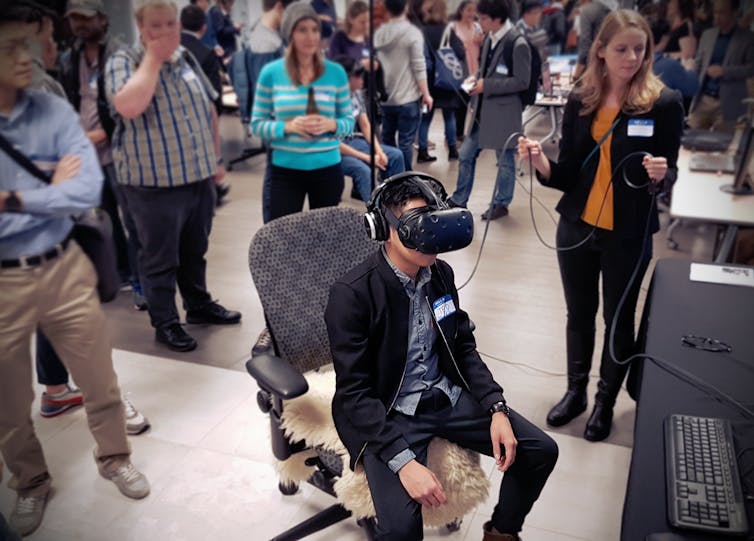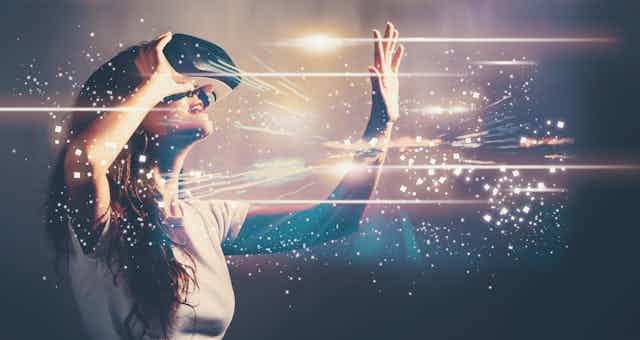“Everyone needs to experience this. Especially if they are going through a rough spot.”
The study participant removed her headset. She still had goose bumps on her arms — even though the room was a toasty 25°C. She had just spent 10 minutes inside our immersive virtual reality (VR) environment.
It was like a surreal dream, and unlike many VR experiences, it wasn’t a game, and the goal was not to entertain or make money. It was research — investigating the potential of awe-inspiring VR experiences to create social connectivity and improve individual wellness.
“I felt more connected to the universe, and that my problems were going to be OK, and going to work out somehow.” She laughed and wondered if this was a bizarre thing to say. As our interview wrapped up, she paused at the door.
“Would it be OK if I can come back and try this again? You know, if I need to?”
Extending our reality
I design virtual reality environments, interfaces and experiences. Under the direction of Dr. Bernhard Riecke, in Simon Fraser University’s School of Interactive Arts & Technology’s iSpace Lab my colleagues and I study how people interact with the technology. We also research how to design these experiences, at a time when few frameworks exist.
Many people today are familiar with immersive virtual reality. This is a multi-sensory, often highly interactive, platform that enables people to be “present” in the virtual environment — to the extent that their body and mind believe what is happening is real.
It draws on multiple senses — using visuals, audio, touch and even scent — to help the participant become emotionally invested.

Each of our senses influences our perception and cognition, and the brain uses these senses to form a reliable model in which we guide our decisions, emotions and behaviour. In an immersive VR environment, we are effectively constructing a real extension to our own reality and how we see the world.
People may look down from a great height virtually and their heart starts racing.
They might physically jump when something unexpected happens in their perceived virtual space.
I’ve seen people cry, hug, dance and meditate in immersive virtual environments. And we find that these VR experiences can be profoundly positive. Our research shows that they can inspire a sense of awe and that this can be socially connecting.
Other research has shown that VR can help foster pro-social attitudes and behaviours as well pro-environmentalist behaviours. It can help medical students understand the lived experience of their patients. And it can facilitate perspective shifts. Viewers of the virtual reality film Across the Line in the United States, for example, showed an increase in empathy towards women having abortions after the experience.
Despite the image of VR as an isolating or goofy solo activity, it can actually bring people together, irrespective of where on the planet they are. And VR can transcend other boundaries, like bias: you don’t know the other participants’ age, gender or appearance.
Perhaps, the most compelling thing VR can do is invisible, and deep within our psyche?
An empathy machine?
My first VR experience was in 2002, when I then entered “Osmose,” created by Canadian artist Char Davies.
The emotional intensity I felt was memorable. As I breathed in and out, a respiration sensor in a physical vest translated my breath into environment variables. It allowed me to rise and fall in a gentle, weightless manner inside the virtual environment.
Inside the headset, I was united with a virtual tree and glowing particles floated around me like fireflies. The experience was profound, and showed me that VR could assist in subtle communication using the body’s own cues. Words weren’t needed, nor was an arcing storyline.
This was important for me as a young adult with a painful inflammatory arthritis condition. For a while, my body and mind felt relieved through a feeling of weightlessness and desire to share the experience with others.

The capacity of VR to expand our mental models is similar to that of generating empathetic understanding — towards others, the planet and even ourselves.
Does this mean VR can “make” a person more empathetic?
Not quite. It could help expand the lens in which you see the world and others. But it is not an “empathy machine” that can automatically create empathy with a button push. When designed with specific experiences and emotions in mind though, like awe, the VR experience can demonstrate great potential to assist us in empathetic understanding and pro-sociality.
Generating awe
On the transformative index of emotions, awe is important. It is one of the few experiences that allows people to transcend themselves and to feel part of a greater collective.
We understand this happens through perceived “vastness or scale,” where a person experiences something huge, and “accommodation,” a process that modifies our existing cognitive schema to include new information.

This doesn’t mean that people always need to see something physically massive. Many people experience awe by watching an inspiring public speaker, by attending a concert or seeing artwork. Regardless, awe is relatively rare for most of us, as our busy everyday lives often don’t include weekly concerts, solar eclipses and visits to natural wonders.
Flying the earth
Virtual reality is a young medium and we are still learning how to design an awe-inspiring or emotionally-moving experience.
Our approach uses research and “co-creation” in collaboration with research participants — to develop design ideas. We design an initial prototype based on what research tells us works, then we try it with people. Based on their experiences, we go back and iterate the design. We repeat the process until we get some consistency of response.
For example, a study we ran in 2016 revealed participants feel a sense of awe when touring the planet in Google Earth VR, and we had some interesting initial findings on pro-sociality. Google Earth VR uses street view and aerial data of our planet that appears life size in the virtual environment; a person can fly anywhere in the world and explore.
Among the participants who reported the highest ratings of awe, nearly half experienced “frisson” — chills and a physical goose bump reaction to awe-inspiring events. And when we dug deeper into the data, these participants also reported a strong social connection during the VR experience.
In our study, one participant suddenly started speaking aloud while in the environment. “The fence is still there, the house looks the same,” he stated. “I remember this place.” He had just visited a childhood home he hadn’t seen in more than 20 years.
An interview afterwards revealed he hadn’t been to his country of birth in seven years, due to a tight budget. He also rarely connected with his immediate family, due to time zone differences. A few days later, he booked a flight. “It’s a milk run, like four stopovers, but it was cheap and I’m doing it!” he said.
An antidote to loneliness
Loneliness is on the rise. In a country where one-person households are the most common type, people are reporting increasing feelings of disconnection. And this is a global trend bringing negative social and health consequences.
VR environments may be an antidote. They may increase feelings of social connection. They may be beneficial for people going through a rough spot.
With the support of Simon Fraser University, Social Sciences and Humanities Research Council (SSHRC), Natural Sciences and Engineering Research Council (NSERC), and through collaboration with The Centre for Digital Media, our team is bringing VR environments into workplaces and homes.
If we can inspire people with diverse backgrounds and skill sets to build their own VR experiences, great things could happen. We’ve just seen a taste through awe-inspiring environments.
The realities we can embody are vast, and the potential to expand our lens on life is magical.

